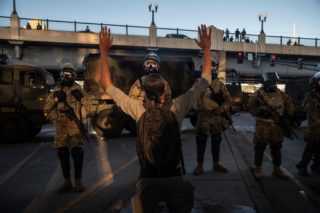
A protester and members of the Minnesota National Guard on Friday.Credit…Victor J. Blue for The New York Times
Gov. Tim Walz of Minnesota activated thousands of additional National Guard troops to send to Minneapolis but declined the Army’s offer to deploy military police units, as days of protests over the death of Mr. Floyd threatened to boil over even further on Saturday.
Mr. Walz, a Democrat, acknowledged that officials had underestimated the demonstrations in Minneapolis, where despite a newly issued curfew, people burned buildings and turned the city’s streets into a smoldering battleground on Friday night. He compared the havoc to wars that Americans have fought overseas, and said he expected even more unrest on Saturday night.
“What you’ve seen in previous nights, I think, will be dwarfed by what they will do tonight,” he said.
Pentagon officials said that Defense Secretary Mark Esper and General Mark Milley, the chairman of the Joint Chiefs of Staff, spoke Friday with Mr. Walz, to express “willingness” to deploy military police units. The governor declined the offer, the officials said, and has since activated all of the state’s National Guard troops, up to 13,200.
Nonetheless, the U.S. Northern Command has put several military police units on four-hour status, which means they could be ready to deploy in four hours, as opposed to a day.
Commissioner John Harrington of the Minnesota Department of Public Safety said that there had been “tens of thousands” of people in the streets on Friday, more than any other night since Mr. Floyd’s death on Monday set off a wave of protests that have become increasingly destructive across the country.
Mayor Jacob Frey of Minneapolis, looking weary after four days of outrage in his city, pleaded with residents to go home and stop burning down the local businesses that he said were even more vital in the middle of a pandemic.
“You’re not getting back at the police officer that tragically killed George Floyd by looting a town,” Mr. Frey said. “You’re not getting back at anybody.”
At least four people have been killed in violence connected with the protests.
One person was killed and three others were injured when a gunman fired shots at a protest in Indianapolis early Sunday morning, bringing to at least four the total number of people killed since Wednesday in violence connected with the protests.
The authorities were also investigating a possible connection with the shooting death of a federal officer in California.
The officer, a contract security guard for the Department of Homeland Security, was shot and killed outside a federal courthouse in Oakland, Calif., on Friday night as demonstrations in the city turned violent, with protesters setting fires, destroying property and clashing with the police.
Ken Cuccinelli, the Department of Homeland Security’s acting deputy secretary, called the attack an act of “domestic terrorism,” but the state’s governor cautioned against connecting the shooting with the protests.
“No one should rush to conflate this heinous act with the protests last night,” said Gov. Gavin Newsom, a Democrat, in a statement.
Elsewhere, people were killed when once-peaceful protests descended into violence.
The authorities in Minneapolis on Friday identified a man killed on Wednesday, whose death was the first to be directly connected to the protests and looting there.
The victim, Calvin L. Horton Jr., 43, was shot to death outside a pawnshop that was being looted.
Also on Friday in Detroit, a 21-year-old man was shot to death while sitting in his car near Cadillac Square, as hundreds of protesters swarmed the streets. The police said the gunman may have known and targeted the victim and used the chaos of the demonstrations as a cover.




